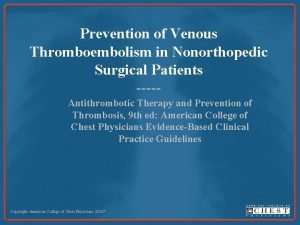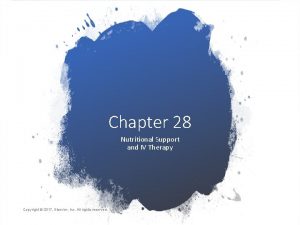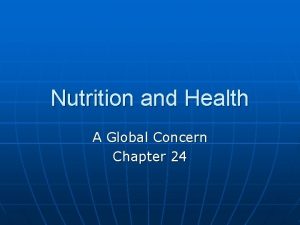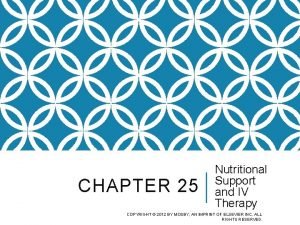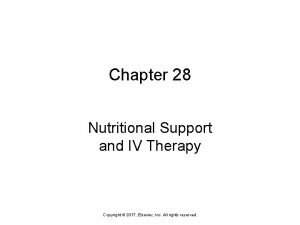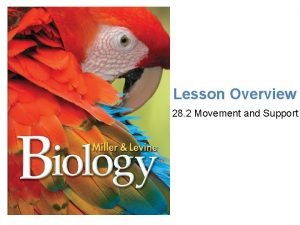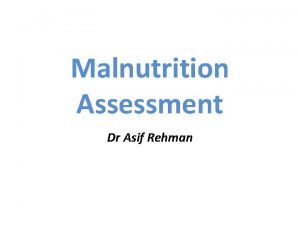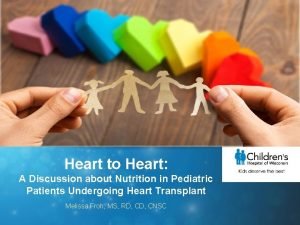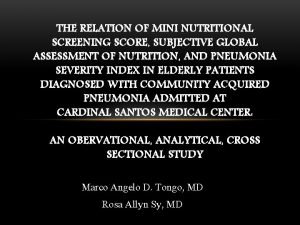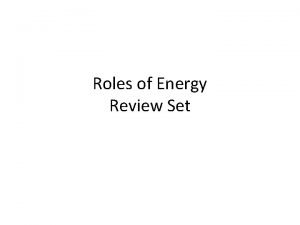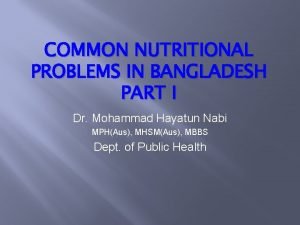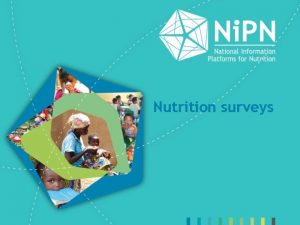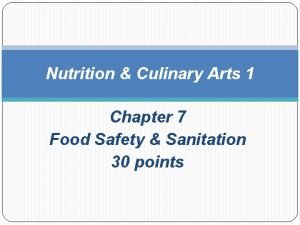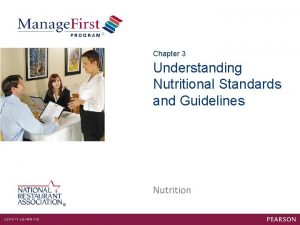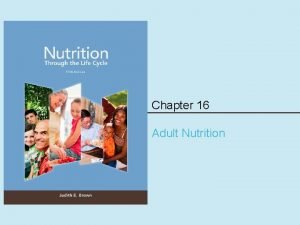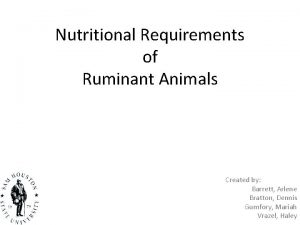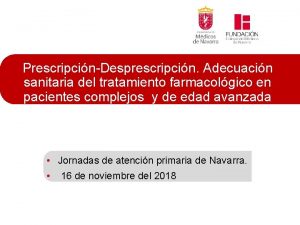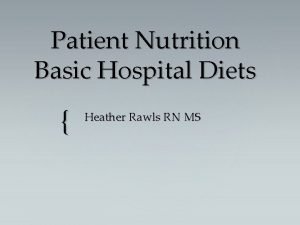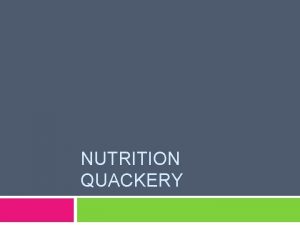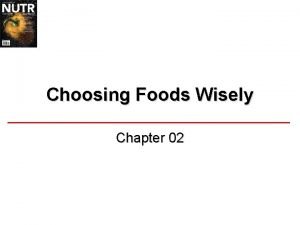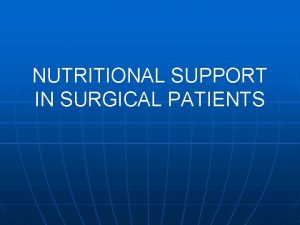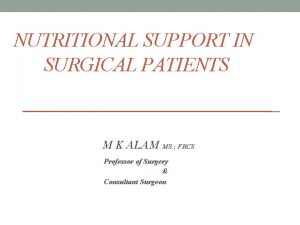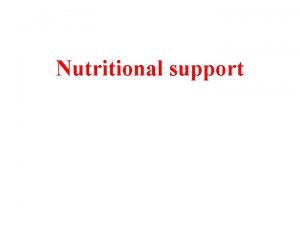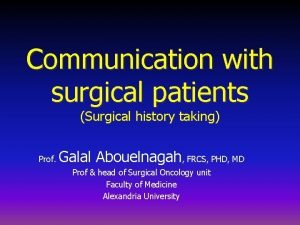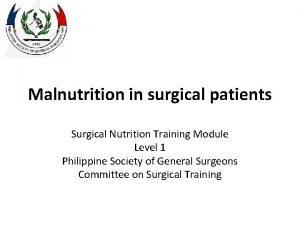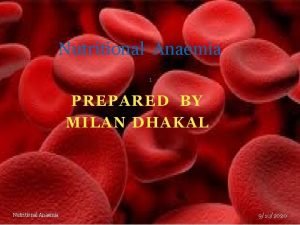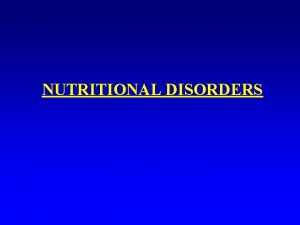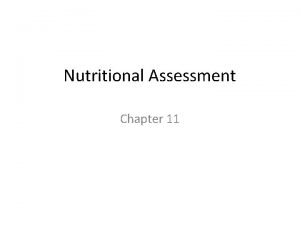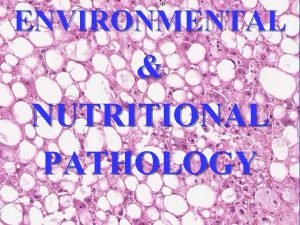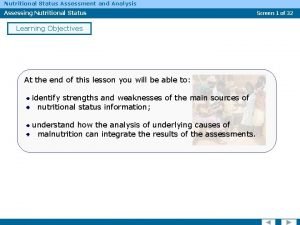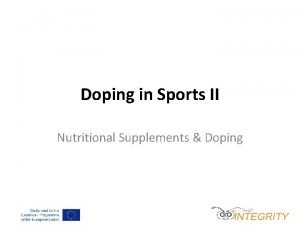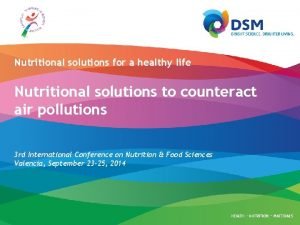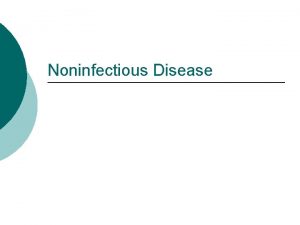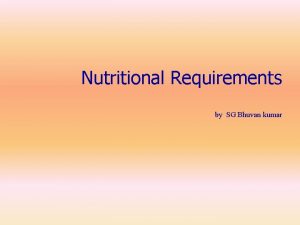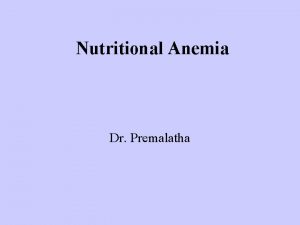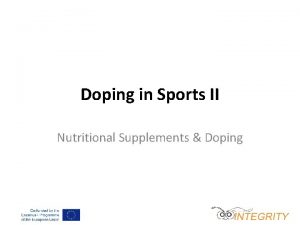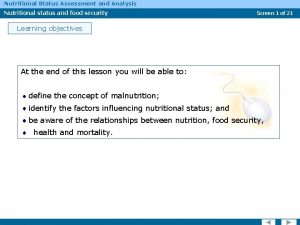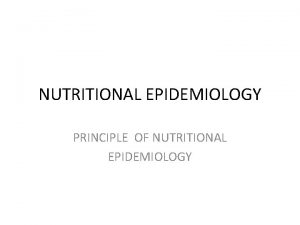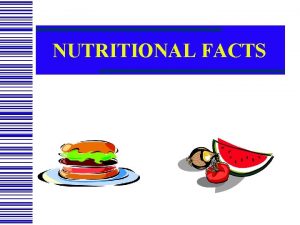Nutritional support in surgical patients Outline of the


























- Slides: 26

Nutritional support in surgical patients

Outline of the lecture • Definition of nutritional support • The Role of Nutrients in the Body • Body's endogenous reserve of major nutrients • Classification of Malnutrition and it’s effect in the body • Nutritional Assessment

Definition • Nutrients is the constituents of food necessary to sustain normal function of the body • Nutritional support The provision of nutrients orally, enterally or parenterally with therapeutic intent.

The Role of Nutrients in the Body • • ESSENTIAL NUTRIENTS: carbohydrates, protein, and fats: supplying energy and raw materials for metabolism. Missing just one of these Essential Nutrients puts the body into a state of being malnourished. ESSENTIAL AMINO ACIDS: required to make proteins they cannot be created by the body ESSENTIAL FATTY ACIDS: Lipids that cannot be created by the body required to make some of the phospholipids.

• VITAMINS: • organic molecules that serve as co-enzymes or parts of co-enzymes and therefore have catalytic functions • required in small amounts • Water-soluble: • B complex, Vitamin C excreted with the urine • mild overdoses are harmless • fat-soluble: E, D, A, K • should be monitored more closely • MINERALS: • Calcium: bone, nerves and muscles • Phosphorus: bone, ATP and nucleic acids • Iron: cellular respiration and hemoglobin • Iodine: thyroxine • Sodium, potassium, and chlorine are important in nerve function • Magnesium, manganese, zinc, and cobalt are cofactors built into the structure of certain enzymes

Body's endogenous reserve of major nutrients including adipose and somatic muscle tissue CLASSIFICATION OF MALNUTRITION MARASMUS -depletion in the somatic compartment KWASHIORKOR -depletion in the visceral compartment MARASMUS-KWASHIORKOR MIX -depletion in both compartments

Malnutrition • 1. 2. • Preoperative Starvation failure of proper digestion Postoperative

Starvation which may be secondary to: • Poverty and inability to obtain food • Dysphagia • Vomiting • Self neglect, e. g alcoholics and the elderly

• Conserve energy by decrease in metabolism Initial loss of glycogen (24 hr), body fat, then skeletal protein • Death is due to weakness of diaphragm, pneumonia or other infection; timing depends on size of fat stores

Failure of digestion • Pancreatic or biliary disease, e. g. carcinoma, stone • Duodenal or jejunal disease, e. g. fistula, blind loop syndrome

• Postoperative malnutrition • Usually result of the stress of surgery and is a transient nature • However, it may be as severe with such major operations as • esophagectomy and paralytic ileus

What happens during acute stress? • Catabolism of body protein (viscera and skeletal) in order to support gluconeogenesis. • Hormones: glucagons, catecholamine, glucocorticoids … promote fluid retention • Cytokine response: fever, inflammation, increase metabolism. • Skeletal protein is depleted

Hypercatabolic states • An increase in metabolic rate and protein catabolism of >25% e. g. 1. Sever sepsis 2. Sever trauma as in burns 3. Sever inflammation as in pancreatitis • Body fat used more gradually • Death is due to weakness of diaphragm, pneumonia or other infection.

Manifestations General • Physical and mental exhaustion • Infection, due to immunosuppression • Intolerance to radio- and chemo-therapy Metabolic: • Lowered rates of enzyme synthesis • Impaired oxidative metabolism of drugs by the liver

Healing problems: • Wound dehiscence • Leakage from bowel anastomoses • Delayed callus formation • Disordered coagulation

Nutritional Assessment How do we detect malnutrition? • History • Physical examination • Laboratory investigations

History • Dietary history • Change in appetite • Significant weight loss within last 3 months v 15% loss of body weight • Compare with ideal weight • Beware the patient with ascites / edema

Physical examination • Evidence of muscle wasting • Depletion of subcutaneous fat • Features of Vitamin deficiency (Glossitis in vit B 12 def , hypertrophic gum : scurvy in vit C def, follicular keratosis in vit A def , pellagra in niacin def) • Echymosis and easy bruising • Easy to detect > 15% loss weight

Physical examination • Weight for Height comparison • Body Mass Index – Wt (kg) / Ht (M)2. – NORMAL BETWEEN 18. 5 – 24. 5

Physical examination Anthropometry – triceps skin fold (TSF) by caliper (minimum : 13 mm in female, 10 mm in male) – mid arm circumference (MAC). – mid arm muscle circumference (MAMC) – (feeding is indicated if less than 23 cm in F and 25 cm in M) {MAMC = MAC cm – (TSF mm × 0. 314)}

Lab Investigations • Albumin < 30 mg/dl • Pre-albumin < 12 mg/dl • Transferring < 150 mmol/l • Total lymphocyte count < 1800 /mm 3 • Tests reflecting specific nutritional deficits – e. g. prothrombin time

• • • Candida skin test Nitrogen balance studies urinary creatinine and 3—methylhistidine excretion total body K and N 14 C--leucine incorporation Fecal fat test Schilling test Hydrogen breath test D-xylose

Assessing Nutritional Status: The SGA A. History • Weight change <5% = “small” 5– 10% = “potentially significant” >10% = “definitely significant” • Change in dietary intake • Gastrointestinal symptoms (nausea, vomiting, diarrhea, anorexia) • Functional capacity • Disease and its relation to nutritional requirements B. Physical • • • Loss of subcutaneous fat Muscle wasting Ankle edema Sacral edema Ascites C. SGA Rating subjective global assessment • • • A = Well nourished B = Moderately malnourished C = Severely malnourished

Thank you

• • • • NOTES ESSENTIAL NUTRIENTS 57% Carbohydrates (sugar, sweets, bread, cakes ( 30% Fats (dairy products, oil ( 13% Protein (eggs, milk, meat, poultry, fish ( Body's endogenous reserve of major nutrients The Carbohydrates provide energy for 24 hr max Brain , RBC and kidney relay on Carbohydrates for supplying the energy After 24 hr the body protein undergo gluconeogenesis to supply energy for the three vital organs Nutritional Assessment The must important (practical) steps History : 10% weight loss in 3 -6 months BMI Albumin and HGB

The Doctor said you may ask to calculate the total calories in MCQs • Calories per gram of: Water = (0 Cal( Protein = (4 Cal( Dietary fiber = (3 Cal( Fat = (9 Cal( Alcohol = (7 Cal( Carbohydrates = (4 Cal
 Prevention of vte in nonorthopedic surgical patients
Prevention of vte in nonorthopedic surgical patients Chapter 28 nutritional support and iv therapy
Chapter 28 nutritional support and iv therapy Chapter 24 nutritional care and support
Chapter 24 nutritional care and support Chapter 28 nutritional support and iv therapy
Chapter 28 nutritional support and iv therapy Continuous feeding vs bolus feeding
Continuous feeding vs bolus feeding Chapter 28 nutritional support and iv therapy
Chapter 28 nutritional support and iv therapy The quote sandwich example
The quote sandwich example Support control and movement lesson outline
Support control and movement lesson outline Major details examples
Major details examples Abcd of nutritional assessment
Abcd of nutritional assessment Malnutrition conclusion
Malnutrition conclusion Subjective global assessment scoring sheet
Subjective global assessment scoring sheet Nutritional diseases
Nutritional diseases As nutritional energy passes through the food chain energy
As nutritional energy passes through the food chain energy Major nutritional problems in bangladesh
Major nutritional problems in bangladesh Importance of nutrition survey
Importance of nutrition survey Culinary nutritional arts
Culinary nutritional arts What is nutritional health
What is nutritional health Concept of nutritional standard
Concept of nutritional standard Nutritional intervention
Nutritional intervention Nutritional requirements for ruminant animals
Nutritional requirements for ruminant animals Major nutritional deficiency diseases in emergencies
Major nutritional deficiency diseases in emergencies Nutritional needs throughout the life cycle
Nutritional needs throughout the life cycle Mini nutritional assessment short form
Mini nutritional assessment short form Clear liquid diet foods
Clear liquid diet foods Nutrition quackery
Nutrition quackery Abcd of nutritional assessment
Abcd of nutritional assessment
